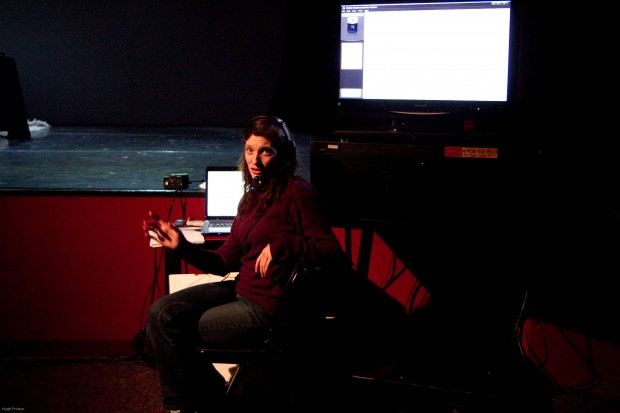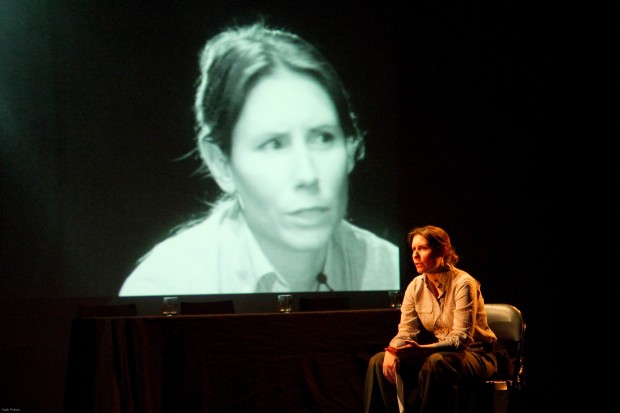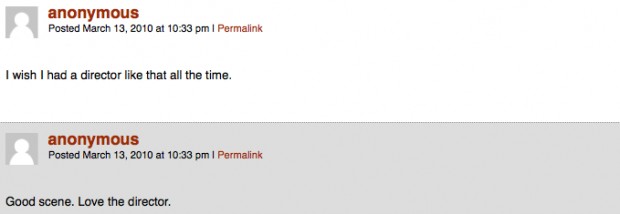Section 98 – Open Source Entry #11 – HATCH Feedback

Melissa Hood looks over her notes during rehearsal. Photo by Hugh Probyn
by Aislinn Rose
In October 2009, Struts and Frets blogger Kris Joseph posted On theatre in society: porosity in response to Mike Daisey’s How Theater Failed America, about the current dysfunction of funding models for American theatre, as well as Chris Ashworth’s Toward a New Funding Model for Theater, in which he argues that “the process is the product”, and therein lies a new approach to funding. Joseph asserts in his post that he is, “now more convinced than ever that theatre can and must distinguish itself from film, TV, and new media by being completely porous to its audience.” He goes on to write that theatre artists must share their process by becoming integral parts of the communities where they work, and that the community should feel completely part of that work.
The post inspired an equally interesting conversation in its comments section, with Praxis Co-Artistic Director & Director of Section 98 Michael Wheeler commenting that the work we were doing with Section 98’s Open Source Theatre project was in part an attempt to make our process integral to our relationship with our audience, in preparation for our work-in-progress presentation for Harbourfront Centre’s HATCH season. We though the issues we were addressing would benefit from discussion and wanted to get our community involved as early in the process as possible.
Another commenter wrote to say that he normally runs screaming from the room when it comes to “art as process” work, with only a few exceptions. However, he was in complete agreement with a point made by Ashworth (in reference to sharing the development process with the audience) about editing out “the boring bits”. Sounds like a good idea, doesn’t it? Easier said than done I think.
It’s been a few weeks since our HATCH presentation and we’re still sorting through the feedback. In an effort to open ourselves up to our community, we recorded our process online and encouraged audience members to text us during the show with the texts posted live to our blog throughout the presentation, and we asked our audience members to continue sending us their feedback after they’d gone home and had a chance to reflect. Some chose to return to our blog with that feedback, and others emailed us or sent messages via Facebook.
Here’s our best attempt to provide an unbiased overview of the synthesis of this feedback under the major categories it addressed.
Open Source/Interactive:

Assistant Director Laura Nordin operated the texting software during the performance and transferred the comments to the website. Photo by Hugh Probyn
A text received during the show:

An unsolicited Facebook message after the show:

Do I want to meet? Hell yes! I had to google “experience design” to find out it was an actual thing.
And in response to the texting:

And from a texter with a smart phone with access to our blog throughout the show:

And from a post-show blogger:
![]()
The Q&A at the end of the show yielded a number of comments on this topic, with many saying they found the texting to be distracting, or that they prefer to lose themselves in the theatre rather than participating in every day life activities like texting. Others really liked that they were able to communicate with us throughout the show, but they wanted to see it further integrated into what they actually see onstage. Lots to think about here!
Multiple Plot Lines:

Greta Papageorgiu presents “Section 98 for Dummies”. Photo by Hugh Probyn
Section 98 was investigating the history of Civil Rights in Canada, with a particular eye on the Communists of the 1930s, the FLQ and the War Measures Act in the 1970s, and Afghan Detainees in the modern era. Some audience members found the inclusion of so much information to be confusing, or questionable:


The audience at the Q&A seemed to divide neatly into two camps on this issue. On the one side there were people who felt that the multiple topics were too scattered and they were having trouble tying it all together. Another perspective suggested this was not the time to condense our story yet… that we should “keep blowing it up and making us make the connections ourselves (which I’m sure we’ll continue to do for several days)” as one participant commented. Or, as it was put another way, “I kind of like you throwing a bunch of shit up there… you’re giving us homework”.
General’s Testimony:

Photo of the Three Generals from my iPhone during rehearsal.
As part of the presentation, we also included verbatim texts of the testimony given by General Rick Hillier, Lieutenant-General Michel Gauthier, and Major-General David Fraser after the explosive testimony of Richard Colvin, in which he alleged that Canadian Soldiers knowingly transferred Afghan detainees to torture in Afghan prisons. Here’s some of what we got during the show:



So we discovered that most people found this material to be deadly boring (including my mom). There were, however, a few people who found the transcripts to be interesting, while others suggested we could absolutely continue working with them… once we had sculpted it with our point of view. “There’s no such thing as neutral.” This is fascinating to me since we had been so concerned about taking the material out of context and were committed to presenting it exactly as we found it.
Omar Khadr:
Image by Darren O’Donnell
Omar Khadr also caused some disagreement. I am, of course, not referring to the real Omar Khadr, the one who was captured at the age of 15 and lives in Guantanamo Bay. I’m referring to another of our Open Source Theatre commenters who went by the moniker of “Omar Khadr” in response to Open Source Entry # 4: Checking for a Pulse. Some of these comments were included in our show. Here are some of the responses this material generated, in the order in which they were received:

Some thought the sections to be “extraneous” or “questionable”, while another said, ““Omar” really turned out to be a lynchpin of the show.”
Fake Omar requested that we not take him out of context so we recorded his text using an imagined internet/robot voice. While people couldn’t agree on whether or not we should have included this material, most could agree that the robot voice should go.
Jim Watts

Margaret Evans as “Jim” Eugenia Watts. Photo by Hugh Probyn
If there’s one thing that most people could agree on, it was Communist/Theatre Artist/Revolutionary Jim Watts… the kind of character I would have liked to encounter in Canadian History classes in public school. Here’s what people had to say about her:



More post-show feedback continued in this vein, with suggestions that Jim really is the anchor of our show. To me, this is one of the most successful aspects of this workshop because we were fascinated by Jim while developing Tim Buck 2 when this show started at the Fringe, but she really didn’t emerge as a centrepiece in that iteration of the project.
What Now?
So, what do we do when half of our audience tells us they hate something about our show, while the other half says, “it was our favourite part”? One commenter may have addressed the challenge of conflicting advice best:
“If I start commenting on Linux, [an open source, collaboratively developed operating system] no one is going to listen, for very good reasons (I don’t know much about code.) So, how, in this world of aesthetic and political difference, can you tell […] who to listen to – who shares any values.”
This question of “who to listen to” is a great one, and will be on our minds as we dig deeper into all of the feedback. Which of the responses can we add to our “source code” to enhance our work, and which responses will “crash” it? As we continue in our efforts to be “porous” with our audience, please stay tuned for Part 2 where we discuss our own responses to the feedback, and where Section 98 is headed.



Congratulation Praxis – sad that I missed it (in a rehearsal at the time).
I’m struck by the idea of feedback, and I smell a dangerous possibility in the texting thing which you hint at here: that you are creating “reality theatre” open an audience that has been “American Idolized”, and sees any request for feedback as their moment to vote or judge. I think what you’re after is a conversation, not a blanket judgement. Someone who texts “boring” is perhaps honest, but fails to actually ATTEND